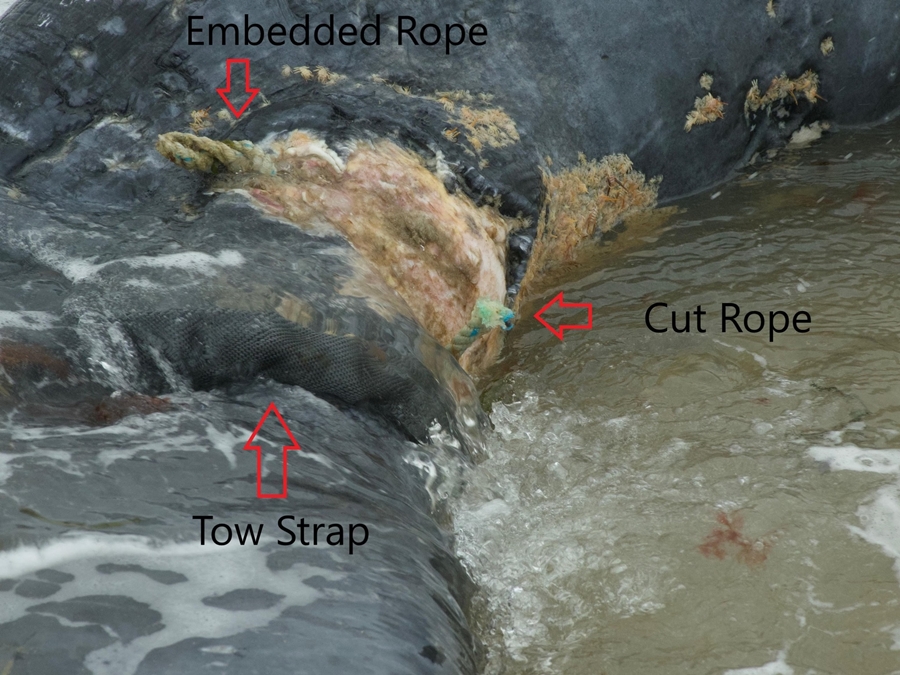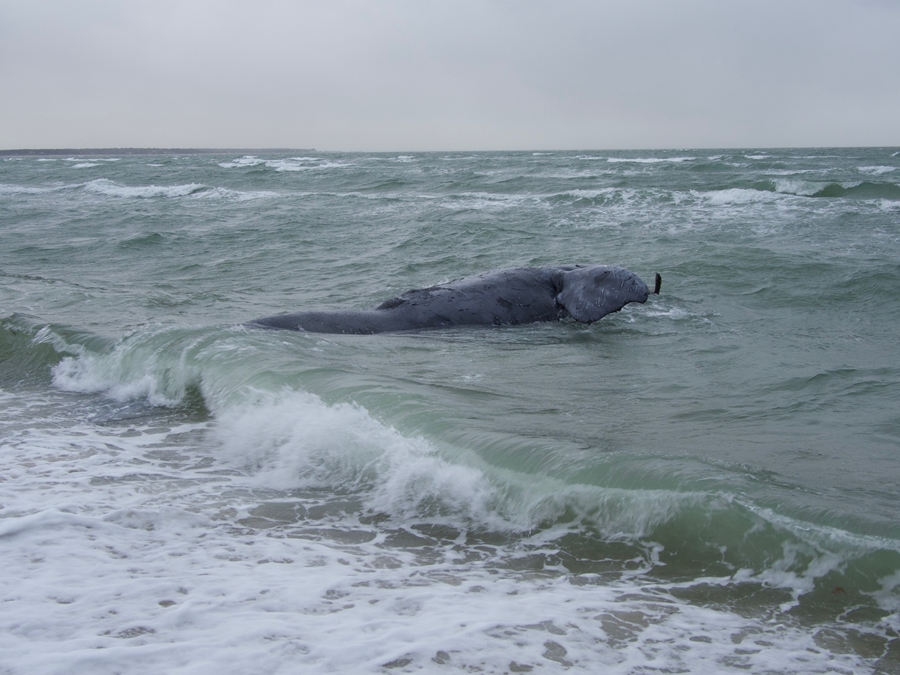This article was updated on Feb. 28, 2024.
PROVINCETOWN — A North Atlantic right whale was found dead near Edgartown on Martha’s Vineyard on Jan. 28. The death represents a significant blow to the right whale population — it is a critically endangered species with only around 360 remaining, according to the National Oceanic and Atmospheric Administration.
Scientists with NOAA and the International Fund for Animal Welfare found rope embedded in the whale’s tail, and a necropsy completed on Feb.1 and involving more than 20 biologists from IFAW and eight other organizations — including the Center for Coastal Studies in Provincetown — determined that the animal’s deep wounds and poor condition indicated entanglement played a significant role in its demise.

Later analysis by the New England Aquarium determined this whale was one known to researchers already: Whale #5120, a three-year-old female that had been entangled in fishing gear since at least August 2022.
While the scientific investigation was unfolding, misinformation began spreading on the internet regarding this whale’s death, including claims that entanglement was not the cause.
The Independent’s analysis of online threads found that nearly all of them proposed that the whale died because of offshore wind turbine development taking place south of the island, and many asserted that NOAA and other authorities had covered it up. These claims spread quickly and over a few days came to dominate online searches for information about the whale’s death — in spite of the fact that the necropsy report presents no evidence that wind turbine construction directly or indirectly influenced it.
The Tragedy of #5120
When this whale washed ashore on Jan. 28, several groups including IFAW and the Wampanoag Tribe of Gay Head (Aquinnah) performed preliminary investigations. Michael Moore, director of the Marine Mammal Center at Woods Hole Oceanographic Institution, photographed a piece of broken-off rope deeply embedded in the tail.

This would not be a rare finding. Entanglement and boat strikers are the two leading causes of death of right whales, and 85 percent of right whales are entangled in fishing gear at some point in their lives, according to NOAA.
On Feb. 2, NOAA Fisheries released its preliminary necropsy results. The report found that the combination of the embedded rope around the tail and the animal’s thin body condition pointed to complications related to chronic entanglement. The New England Aquarium confirmed the whale was #5120, the only known calf of Squilla, or #3720.
In August 2022, #5120 was spotted off New Brunswick with fishing gear tightly wrapped around its tail, dragging two buoys and 200 feet of rope behind it. According to NOAA, this entanglement was deemed serious because #5120 was only a year old at the time, so the wrap was likely to tighten around her tail as she grew.
Four months later, in January 2023, the entangled whale was spotted in Cape Cod Bay. The Center for Coastal Studies Marine Animal Entanglement Response team attempted to remove the rope but did not succeed. According to the report, the wrap was difficult to manipulate because the rope by then lacked trailing gear; distance from shore and poor weather conditions were also factors.
The whale was seen again off New Brunswick last June. It was noticeably thinner, and the wounds from the rope around its tail had gotten worse. By the time it washed up on Martha’s Vineyard, it was in bad shape.
A loss of a juvenile whale like this is “devastatingly bad,” Moore told the Independent. With a population this small, each lost right whale brings the species one step closer to extinction. Worse still, Moore said, the whale was a female. “If you lose a young female,” Moore said, “you’re losing potentially 7, 8, 10 future calves that she’s not going to deliver.”
There are currently thought to be fewer than 70 living reproductively active female right whales, according to NOAA.
A whale’s death driven by chronic entanglement is likely to be a painful one, said Moore. “The rope is cutting into the skin, through the blubber, and oftentimes, the bone,” he said. The wounds can’t heal because the rope becomes embedded as the animal swims. As the tail goes up and down, the rope “cuts in like a saw,” he said.
These injuries, he said, can cause starvation and infection. Moore also recalled one entangled whale that had died from overheating, as the rope constricted the blood vessels that bring blood to the tail to dissipate its body heat.
“Your prognosis as a lethally entangled animal is about six months,” Moore said.
Preventing more deaths like #5120’s will be a challenge. NOAA has instituted seasonal closures of lobstering in areas where right whales aggregate, including Cape Cod Bay, and has implemented regulations to reduce the likelihood and severity of entanglement. They have also tested the efficacy of “ropeless” fishing gear in restricted zones, though those tests have received mixed reviews from fishermen, as previously reported in the Independent.
Sources of Misinformation
Doubts about the entanglement appear to have originated with a series of Instagram posts by Nisa Counter, made the day the whale washed ashore. Alongside photos of the dead whale and a video of it being towed ashore, she claimed in her captions that there was no evidence of an entanglement.
“They will tell you it was entangled it was not. I saw with my own eyes,” she wrote.
Counter blamed Vineyard Wind, the ongoing offshore wind project 12 nautical miles south of Martha’s Vineyard, for the death. Within two days, Counter claimed, her video had been shared over 1,000 times.
Currently, the only activity at the Vineyard Wind site is above the water’s surface — construction of the foundations is paused from Jan. 1 to April 30 to protect right whales.
NOAA Fisheries soon released its labeled photos of the whale’s tail that clearly showed rope embedded in it. But when it posted those photos on Facebook, claims similar to Counter’s quickly spread through the comments.
“Where is the rope. Where?” commented Matthew Fontanez on NOAA’s post.
“There was no rope on this tail NOAA put it there,” wrote Zach Miller on the same post.
“The rope on the tail was tied on after the whale washed up on the beach,” commenter Tim Holmes wrote.
Of the 265 comments on the post made the first week it was published, about one-third asserted that NOAA was falsifying the report, and about a quarter blamed wind energy construction for the mortality. Many people cited “eyewitnesses” who claimed to see the whale without rope on its tail. A few commenters linked to Counter’s Instagram post directly.
Counter later acknowledged in another Instagram comment that she saw the photo of rope around the whale’s tail but asserted it was too small to have caused its death.
Distrust of the researchers’ reports was not limited to individual social media commenters, however. Save the Horseshoe Crab, an environmental nonprofit that is part of the Save Right Whales Coalition, repeated the misinformation on its Facebook page, writing that “eyewitnesses on the scene said there was no gear found on the whale” and stating that the whale was close to the wind energy construction area.
The Save Right Whales Coalition was founded by Lisa Linowes, an anti-wind activist who was a senior research fellow at the Texas Public Policy Foundation, an organization that works to deny the facts of climate change, according to a December 2023 report by Brown University’s Climate and Development Lab.
In a Facebook group run by ACK for Whales, another environmental nonprofit working against wind energy, misinformation was again shared widely, including by Counter.
ACK for Whales (originally called Nantucket Residents Against Turbines) was part of the American Coalition for Ocean Protection, a collection of organizations fighting against wind energy and founded by the climate change-denying Caesar Rodney Institute. According to the Brown University report, the coalition brings together the John Locke Foundation, the Mackinac Center, the Thomas Jefferson Institute, and the Maine Policy Institute. Each of these organizations, as well as the Caesar Rodney Institute, received at least $20,000 in donations from fossil fuel industry groups. (ACK for Whales board members told the Independent that the group is no longer a member of the coalition.)
Within days, the conspiracy theory had grown popular enough that other publications began discussing it. Writing in the Nantucket Current, the online newsletter of Nantucket-based N Magazine, reporter Jason Graziadei included Counter’s claims alongside NOAA’s description of events in an article about the young whale’s death published on Jan. 30.
Graziadei told the Independent his publication included Counter’s claim “because she was one of the first people to discover the whale and witnessed some of the efforts to bring it up on the beach. She and others on the Vineyard questioned the official account that was being provided by authorities, so we wanted to know more about what she said she saw.”
As the Independent reported in October, many prominent whale biologists dispute the notion that wind energy infrastructure poses a threat to whales. Compared to the threats whales face from the shipping industry, entanglements, and climate change, offshore wind construction is “a little dot,” said Christopher Clark, a retired senior scientist and graduate professor at Cornell University with expertise in marine acoustic ecology.
Moore agreed, saying there was no evidence that noise associated with the sonar used in wind companies’ surveying could kill whales.
Conspiratorial thinking is common in anti-wind circles, according to J. Timmons Roberts, a professor of environmental studies and sociology at Brown University and a lead author of the Brown report, which reveals links between fossil fuel interests and climate denial think tanks — a dynamic that has pushed the movement against wind and its theories about whale mortalities into the mainstream.
As more details surrounding the death of Whale #5120’s death become available, misinformation has only grown. As of press time on Feb. 6, 80 percent of commenters on the latest NOAA Fisheries Facebook update on the whale’s death claim the report is falsified, and many comments argue that wind energy is to blame.
As for #5120 herself, she will be laid to rest by the Wampanoag Tribe of Gay Head (Aquinnah) once the appropriate ceremonies are performed. The tribe wrote in a statement, “Wampanoag People consider the whales to be our ancestors … May this Daughter of The People of the First Light rest easy and be at peace.”
Editor’s note: An earlier version of this article, published in print on Feb. 8, stated that ACK for Whales is part of the American Coalition for Ocean Protection. It now appears that the Nantucket group has withdrawn from membership in that coalition.



